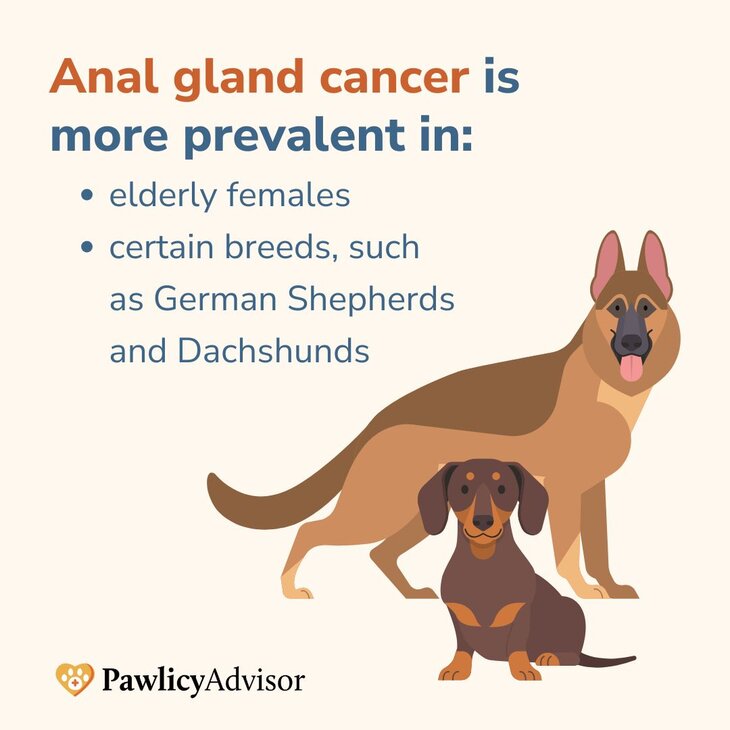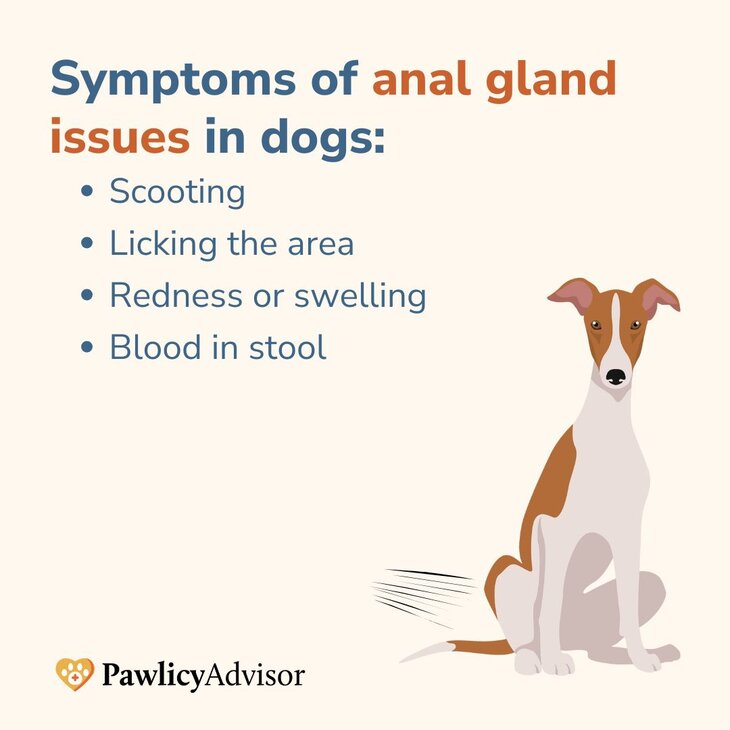Dog Anal Glands: Everything You Need to Know
Most dogs may not have any issues with their anal glands throughout their whole lives. Dogs' natural gland expression during a bowel movement releases fluid from the anal glands.
When dogs are afraid or under stress, they may also unintentionally release fluid from their anal glands. During a typical bowel movement, a dog might mark their territory in their yard or close to their house by expressing their anal glands.
Likewise, when dogs get together, they sniff each other's back ends and anal glands to determine the other dog's hormonal condition. Dogs may develop complete, impacted, or diseased anal glands. Dog anal gland diseases or obstructions can cause discomfort, so it's critical to identify the warning symptoms and know what to do if they occur.
This piece will cover everything you should know and when to take your dog to the vet if there are problems with the anal glands.
Your pet's health is priceless — let's protect it together.
Table of Contents:
What are dog anal glands?
Dog anal glands are two little pockets, each approximately the size of a pea, found on the right and left sides of the dog's anus. Each gland links to a tiny tube that releases a peculiar, foul-smelling fluid. The stool usually pushes against the glands in the anus and discharges (expresses) the fluid as it travels through.
Types of dog anal gland issues
Anal sac illness in dogs is a broad phrase that comprises a few particular disorders. Among them are:
Anal gland impaction
Dogs with impacted anal glands will experience mild discomfort. This pasty brown substance plugs the sac and becomes a hard mass-effect while the anal gland liquid thickens. In several cases of impaction, you may express the anal glands in dogs under substantial pressure.
Anal gland infection or abscess
A dog with an abscess or infection of the anal glands will be in moderate to severe pain. Pus accumulates inside the gland and causes disease due to germs from the illness. When the gland orifice becomes clogged due to the pus-filled sac and swollen tissue, an infection may worsen and develop into an abscess. You may notice discoloration surrounding the anal region or a red, hot, swollen patch on the back end, usually near or inside the anal hole.
A ruptured anal gland abscess
If you don't treat an abscess, it may rupture, causing severe discomfort to your dog. The ruptures (fistulas) extend from the anal gland to the skin. You may notice greenish-yellow or crimson pus flowing from the burst gland.
Anal gland cancer
Cancerous tumors may also appear in the anal glands. The most prevalent kind of anal gland cancer is apocrine gland anal sac adenocarcinoma (AGASACA). This ailment may not create pain for your dog. It's frequent in elderly female dogs and certain breeds, including German Shepherds and Dachshunds.

What causes anal gland problems in dogs?
- Insufficient dietary fiber
- Changing stool consistency (soft stool, diarrhea, or constipation)
- Chronic skin disorders, such as seborrhea, infections, and itchy skin.
- Obesity
- Internal and external parasites
- Allergies to foods or environments
- Genetics (more prevalent in tiny breeds)
Additionally, dogs with previous anal gland issues may be more prone to experiencing them again due to the inflammation causing scar tissue.
Symptoms of dog anal gland issues
Here are some of the common signs that your dog is experiencing anal gland problems:
- Scooting: Scooting results from uncomfortable or overfilled anal glands. Skin itchiness, allergies, and skin infections can all cause your pet to scoot, so consult your veterinarian if it is a recurring issue. Some dogs with normal-sized glands will still scoot and would benefit from getting them emptied.
- Licking the region
- Redness or swelling of the skin around the glands
- Blood in feces, hair, or carpet
Consult your veterinarian if these symptoms continue or impact your dog's behavior.

Treatment and prevention of anal glands issues in dogs
See your veterinarian if your dog is exhibiting any of the symptoms associated with an anal gland condition. Your veterinarian can physically express the sacs. They may also administer an antibiotic or supplement if there's an illness.
Consult your veterinarian about your dog's food to prevent anal gland issues. They could advise you to give your dog more dietary fiber and fish oil in their diet. A popular diet addition includes canned natural pumpkin, cooked organic pumpkin, and unsalted pumpkin seeds. Read the label to ensure the canned pumpkin doesn't contain xylitol, which is lethal to dogs.
Ahead of visiting the vet, consider investing in pet insurance to provide support in case your dog needs emergency treatment. Veterinary care can be costly, and pet insurance offers a safety net, reimbursing you for a portion of these unexpected vet expenses.
To find the best plan for your pup and your budget, you can use Pawlicy Advisor to easily compare plans side by side and find an affordable policy.
How to determine if a dog's anal glands are full
The majority of dogs express their anal glands automatically. If a dog's nutritional demands are satisfied with high-quality food, maintain a healthy weight, and get plenty of activity, it's not necessary to express their anal glands.
You don't need to take any action if your dog is not having problems. If you want to do routine expressions, see your veterinarian. If the anal glands are not bothering your pet, your veterinarian can advise leaving them alone, or they might consent to express them to prevent health problems routinely.
On the other hand, if your dog's stool consistency shifts, their anal glands might not be able to express themselves naturally. Eventually, the glands' liquid will thicken, making it more difficult to express.
The glands may become affected, swollen, irritated, or even infected if this occurs, in which case, seek veterinary guidance and treatment. Consider an anal gland expression every three to four weeks after symptoms and problems arise to keep the problem from recurring.
How to express dog anal glands
Your veterinarian may advise you to conduct a dog anal gland expression at home if you feel comfortable doing so. However, if you notice blood or pus around your pet's anus, or if your dog appears uncomfortable, do not try to express their anal glands at home. Instead, schedule an appointment at your local vet.
To express the dog's anal glands, follow the instructions below:
- If your dog is tiny, set them on a table or counter. If your dog is huge, you can squat behind them.
- Have someone else hold your dog by putting one arm around their neck and below, and then the other arm around the rest of their body to give them a tight embrace.
- Put on latex or comparable gloves and lube the index finger with a water-based lubricant or petroleum jelly.
- Raise your dog's tail, then gently press your index finger about an inch into the rectum. Squeezing the exterior of the anal gland maybe be easier at home.
- Use your thumb and index finger to feel at the 5 or 7 o'clock positions for a hard pea- or marble-sized item.
- Once you have located a gland, put a paper towel between your hand and the pup's anus and gently squeeze the gland's furthest side, pressing the gland toward you to release the contents. Don't exert more significant force than you would be comfortable with, say, if you were pushing on your eyes.
- When the gland is empty, you should be unable to feel it.
- Clean the anal region.
- Repeat on the opposite side with the other gland.
If you feel uncomfortable the first time, have your veterinarian show you at your next visit.
Looking to save on vet bills? See which pet insurance is right for you.
Instant results. 1M+ pet parents served.
⭐⭐⭐⭐⭐ 4.9 stars across hundreds of reviews.
See which pet insurance is right for your best friend.
Do you want to find the best pet insurance?
Let's analyze your pet's breed, age, and location to find the right coverage and the best savings. Ready?
Analyze My PetAbout Pawlicy Advisor
The pet insurance marketplace endorsed by veterinarians, at Pawlicy Advisor we make buying the best pet insurance easier. By comparing personalized coverage and pricing differences we can save you a ton of money, up to 83% in some instances!
Instantly Compare Pet Insurance Plans
Guides
Determine If Pet Insurance Is Worth It
Comparison Charts
Find Your State
Dog Insurance
Small Animal Relief Veterinarian
Lila Batiari, DVM is a relief veterinarian located in San Diego, California. She has a special interest in nutrition, pain management, and surgery! Dr. Batiari enjoys working with Pawlicy Advisor to help others avoid everyday situations that some of her clientele experience. She realizes that expensive vet bills for treatment costs could be much easier for patients with pet insurance.
